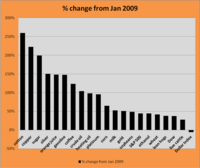The True Drivers Behind Commodity Price Increases
SEE ALSO Alcohol and Driving DO Mix
Washington DC February 16, 2011; Wheat, sugar and copper – the list of commodities seeing price increases goes on and on.
According to the New York Times, commodity prices across the spectrum are rising. In fact, “[c]otton prices are near their highest level in more than a decade… and leather and polyester costs are jumping as well. Copper recently hit its highest level in about 40 years, and iron ore, used for steel, is fetching extremely high prices.”
There are clear cost pressures from virtually everywhere, yet one commodity is taking the brunt of the criticism: corn.
Why? Because corn is the low-hanging fruit when it comes to the commodity blame game. Corn is used in everything from feed to high fructose corn syrup to ethanol, so naturally an uptick in corn prices is going to cost you more at the grocery store, right? Well, not necessarily – grain costs contribute to a fraction of grocery increases, but not nearly as much as higher energy and oil costs force up prices.
The cost of raw materials accounts for a fraction of the cost of most consumer goods, and processing, packaging and transportation make up a larger share of the price on the tag. And processing, packaging and transportation costs are all driven by oil prices.
With the price of a gallon of gas well over $3 on average, Americans are starting to see prices rise on every day expenses, including groceries, clothing, and other personal items.
In addition, what really stands out as a factor to rising commodity prices is the effect that severe weather has had on global agricultural production. And these severe weather events have been tied to the rising concentrations of greenhouse gases in our atmosphere — a direct result of our increasing dependence on oil.
In fact, our nation’s addiction to oil significantly impacts our air quality. According to University of Nebraska Asst. Professor Adam J. Liska, for every billion dollars spent in military activity to access oil in the Middle East, U.S. military operations emit 289,000 tons of carbon dioxide.
Fortunately, we have an alternative that can help reduce gas costs and reduce emissions all while creating food and fuel: American ethanol.
Critics of ethanol would like to deny this fact, but grain ethanol produces both food and fuel. When a corn kernel is headed for production into ethanol, all that is taken out is the starch, which is converted to alcohol. The rest - the protein, the fiber, and the oils – is returned as a high protein animal feed or distillers grain.
And, ethanol helps keep gas prices down because it competes with gasoline, replacing gasoline in the fuel supply and lowering demand. Ethanol is a domestically-produced, renewable fuel that is 59 percent cleaner than gasoline refined from oil.
The more ethanol we use in our fuel, the less dependent we are on foreign oil from countries like Saudi Arabia and Nigeria.
Every day, ethanol is getting cleaner and more efficient to produce, while oil is getting dirtier, costlier and riskier to extract. At the same time, even in tough weather conditions, American farmers were able to produce more than enough grain last year to satisfy our food and fuel needs –on fewer acres of land.
The full extent of today’s price increases is yet to be determined, but one thing is clear, if we want cut costs, boost our economy and save the planet, we must implement policies that will increase the use of renewable fuel and decrease our reliance on oil.



